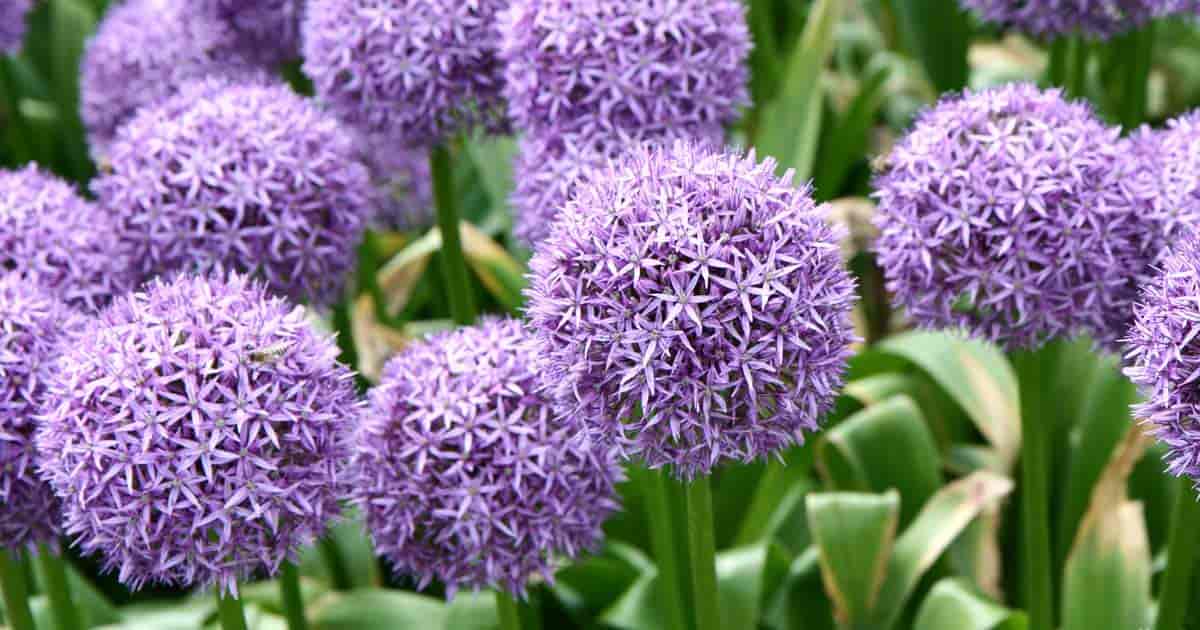Allium giganteum [AL-ee-um jy-GAN-tee-um or gy-GAN-tee-um] is a perennial ornamental onion hailing from Central Asia and the Himalayas.
This “giant onion” belongs to the Amaryllidaceae family. The Latin (Allium) means “garlic” and (giganteum) means giant.

Allium giganteum is commonly known as giant onion or flowering onion.
Allium Giganteum Care
Size & Growth
Of the various Allium species of ornamental onions, giganteum is the tallest species. The plant can grow 3′ to 5′ feet high and spread 1-1/2′ to 2′ feet. Divide and replant bulbs every 3-4 years.
Flowering & Fragrance
The showy, fragrant, purple blossoms appear from May through June. The bloom time lasts for about three weeks.
Tall, strong stems (3″ to 4″ inches high) emerge from the center of the basal rosette early in spring.
By late spring, large, showy, round clusters of purple flowers appear. These flower globes are about the size of a softball and quite impressive.
Foliage Of Allium Giganteum
Foliage grows in a basal rosette which is greenish gray in color. The leaves are approximately 18″ inches long, fragrant and strap-shaped.
Stems and leaves of the giant allium plant smell like onions, but this is not an edible plant. It is the only member of the Allium family grown for its large flowers.
Lighting For Giant Allium Bulbs
In the United States, this Allium bulb is hardy from USDA hardiness zone 5 through 8. The Giant Allium requires full sun exposure and protection against high winds.
Watering and Feeding Requirements
Allium has only moderate watering requirements. Saturate the soil after planting. Apply a flowering bulb fertilizer at planting. You will not need to fertilize again.
Once established the plants are drought tolerant. If you get regular rain, you may not need to water at all. Never allow plants to stand in water for extended periods of time as the bulbs will rot.
Soil Requirements & Transplanting
Ornamental Allium flowers do well when:
- Situated away from strong winds
- Planted in full sun
- Planted in fertile, well-drained soil
Plant giant allium bulbs 5″ or 6″ inches deep and 9″ inches to a foot apart.
When transplanting or moving plants, wait until the end of the growing season after the foliage has died back.
Take up the bulbs, divide them as needed and replant.
Ornamental Onion Grooming & Maintenance:
After plants bloom, the leaves will die back leaving only the tall, erect stem and pom-pom blossom. You may need to stake the stem to prevent collapse.

How To Propagate Allium Giganteum
Leave large bulbs (2″-3″ in diameter) in the ground to spread or take them up annually, divide and redistribute. It is wise to take them up at least once every three or four years to prevent overcrowding.
At the end of the growing season, dig up the allium bulbs in the fall, divide and replant or leave them in place.
If leaving the bulbs in place, reduce watering until the stems have withered and died. Cut off the dead vegetation even with the ground.
Apply heavy mulch to protect the bulbs during the winter.
To divide bulbs and increase your planting, lift the bulbs with a trowel. You will find there are several bulbs connected.
Use your fingers to separate them gently. Amend the soil and replant bulbs at the proper spacing.
Related Reading: Growing The Pregnant Onion [Ornithogalum caudatum]
Giant Allium Pests and Disease Problems
Giant Alliums do not experience many serious diseases or pest problems. These “large onions” are also deer and rabbit resistant.
Like most bulbs, they are prone to rot if the soil is too wet.
Plants in full bloom, are top-heavy. Locate your Allium bed in a sheltered area where wind cannot damage it. It is usually necessary to stake the large flowers and plants to prevent them from tumbling over.
Is “Giant Garlic” Toxic?
Information on the toxicity of this plant is conflicting.
All plant parts are considered mildly toxic — reactions such as diarrhea, nausea and vomiting and not uncommon.
There is also information suggesting that the bulblets, bulbs, and leaves can be used cooked, raw, pickled and as a seasoning.
All-in-all, best practice would be to use one of the many other types of Allium intended as a food crop in the kitchen. Leave the Allium gigantea in the flower garden.
Best Uses For Ornamental Allium Giganteum
The flowering onion is a dramatic and unusual flowering bulb. It adds a great deal of interest to any garden.
They make a good choice as bedding plants, cut flowers and exhibition plants.
These plants look best when 5 to 7 bulbs are grouped together. Because they are so tall, they make a very dramatic background plant.
A border of ornamental onions planted along a back fence makes a lovely definition.
source: 1
